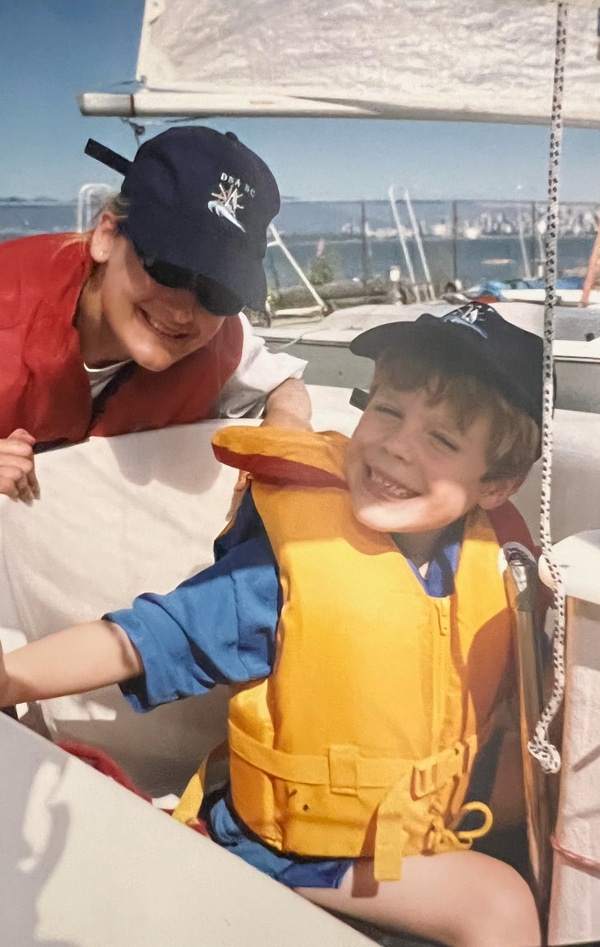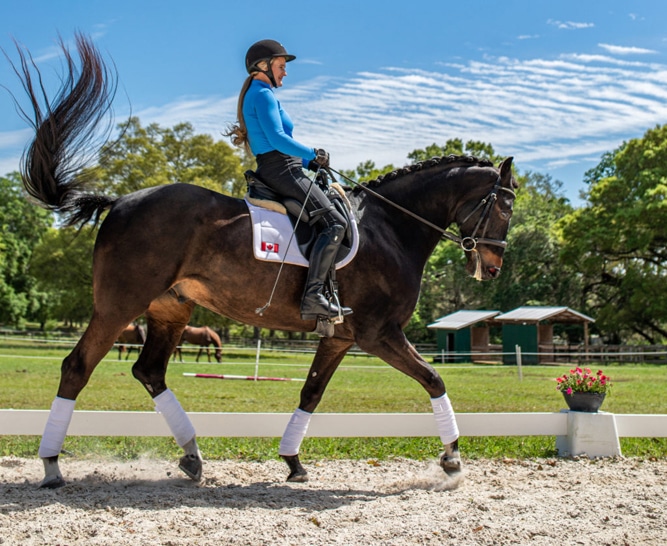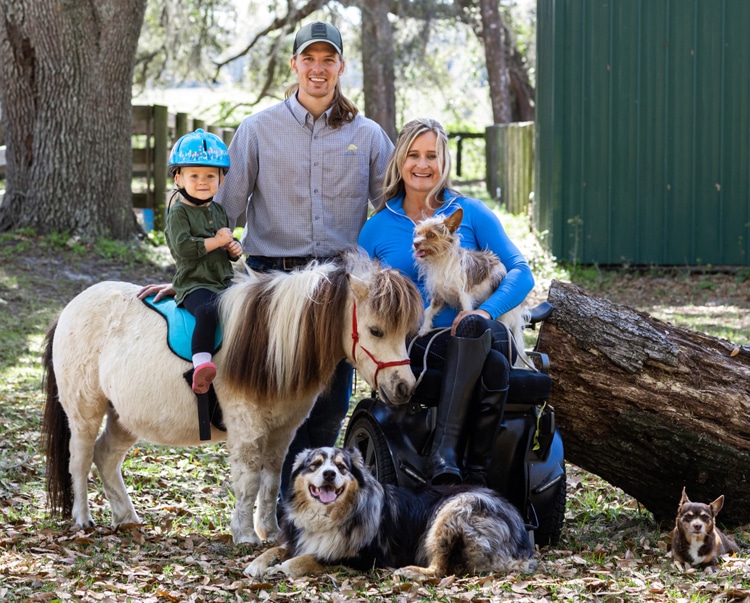Perched on the ninth floor of a rehab hospital in Vancouver, weeks following her spinal surgery, Lauren Barwick could not even crack a window open.
They told her the windows were locked because people with her “kind of injury” – those dealing with paralysis and sudden disability – were often suicidal, recalls Barwick, now speaking from her family home on her 20-acre farm in Reddick, Florida.
Her four-year-old daughter, Viola, barrels into the room, her blonde hair visible in the corner of the Zoom screen.
Calling up that moment from summer 2000, Barwick says she remembers being frank with staff. “I said I can’t move half my body and it’s pretty dead weight (so) if I had the ability to drag myself out of this hospital bed, fall to the floor, climb up the wall and throw myself from the window, maybe…maybe it was my time,” says Barwick, glancing at the floor.
While it is meant as a joke, neither of us laugh.
Early on in occupational therapy Barwick says she learned that humour was the “key.”
“I tried to laugh about stuff and the ridiculous challenges that I ran into. I’d say to my mom, ‘I can’t even reach the toaster anymore’ and she would say ‘you never used the toaster, so like what’s the point’?” says Barwick with a chuckle.
But it was not always like that– the humour, the smiles, the ability to see the bigger picture in how this injury would mark the start of her career as one of the most decorated para-dressage riders in the country who would go on to participate in five Paralympic Games, including the 2020 Games in Tokyo.
Rather, Barwick notes that the days, weeks and months following her accident were filled with mourning and “devastating sadness”; she was consumed by her life-altering accident which seemingly took away her passion and livelihood at the age of 22.
The Accident
It all started in British Columbia when she was hired as a full-time stunt woman by a full-service film studio ranch. Raised around horses in Aldergrove, BC, she combined her love for all things equestrian with her interest in acting.
She felt as though she “lucked out”, getting to care for horses on set, performing extra work, background work and stunt riding some of the most difficult and dangerous horses out there –even working on big-budget projects such as The Black Stallion TV series and The Pledge with Jack Nicholson.
Unfortunately, her life changed dramatically inside of a couple of weeks. In June 2000, just two weeks after her full-time hire, during an early morning feed a haystack fell, whacking Barwick on the back and paralyzing her instantly. As she calls it, she ‘lost at Jenga’ that day, choosing the wrong 100-pound bale of hay to pull out from the barn’s tightly-packed stack.
“They said it’s as bad as it can get,” says Barwick, recalling that first consultation with doctors at Vancouver General. “They give you a grade A, B, C, D and A is the worst; it was a severed spine. So [my spine] is still attached but it was like half my spine is to the right and half my spine is to the left. That was it.”

Lauren took up sailing after her accident as part of her rehabilitation program, shown here with one of the kids she assisted during day camp trips. (Photo courtesy of Lauren Barwick)
That was also “it” for riding. Barwick decided to a make clean break, take a step back, and opted to try new activities as part of a rehabilitation program.
One key moment in her recovery came while taking up sailing, when staff recruited Barwick’s help for a trip with a group of kids.
“I said, you remember I’m paralyzed, right? And they say no, no, no, don’t worry, we know and we think you can do it,” says Barwick, who noted that some of the parents were more than a bit taken aback by her condition.
“So I came down, and I’m dragging my half-limp body into the boat,” explains Barwick, smirking. “The parents are looking over like ‘what’s happening here,’ and I said, ‘don’t worry, they’re totally convinced that I can do this.’”
That day she remembers helping one kid in particular, a young boy with autism.
His parents, upon drop-of, handed Barwick a rag, informing her that their son tends to throw up “whenever he’s happy.”
“So here I am streaming across the bay in Vancouver, and he started laughing and smiling and I reached for the rag and realized very quickly that even under the circumstances with my being paralyzed, I could still contribute to society,” says Barwick.
“It was really important because it is important to participate, not just to be using or asking. It’s like, what can I still do, because I think everybody in life needs to also give back and be a part of something.”
That was the first moment where she felt like her disability wouldn’t take away her agency, quality of life and her ability to live it as she wanted.
Back on the Horse
She put that philosophy in practice months later when she decided to get back on the horse – literally.
It was a during a lungeing lesson when Barwick visited her trainer, Sandy Diamond. Watching someone else train her horse, Barwick says she felt an overwhelming wave of sadness.
“In my mind that person had the [ability to make a] decision, to do whatever they wanted to. They could decide never to ride again. And I realized that was taken away from me in my mind,” says Barwick.
Angry, she began to wheel away in her chair when her coach caught up to her.
“Sandy said that’s it, you have to get back on the horse,” says Barwick, noting that she was not convinced it was a good idea at the time.
“They were pretty persuasive. And when they lifted me up to get me on, it was the worst feeling ever,” she says, ringing her hands. And although she went home angry, that night brought with it a revelation, a realization, explains Barwick, her voice getting quiet.
“I realized that the decision was mine, at the end of the day,” says Barwick. “And if I quit now, I can’t say that riding was taken away from me. So I went back to the barn the next day and that’s really where the journey began.”
Starting out in Western saddle, Barwick was training on Diamond’s horses when the Canadian Paralympic team first reached out.
“Some people came by and said, you know, we’re yada yada with the centre and would you be interested in doing para dressage. I thought it was just a bunch of paralyzed people,” says Barwick, laughing at how this experience educated her on the parasports industry. “And they’re like, no, you honestly have no idea what these people with disabilities are capable of doing.”
They were right. She first witnessed the quality of the sport when she attended a show in New York. As she puts it, she was “hooked” thereafter.
“[These athletes] can bring home medals, but they also compete in regular competitions, and I was like, wow… I wanted to do this for the rest of my life,” says Barwick, who notes that although she was in it for the “long haul”, the training required a steep learning curve.

Lauren is a 4 star Parelli Professional Instructor at her Bridging the Gap Horsemanship in Reddick, FL. (Photo courtesy of Lauren Barwick)
“Dressage is about the finest details and training the perfect circle or the perfect line, the perfect everything. So I had to learn that, but I also had to learn how to ride being disabled.”
It was following her Paralympic debut in Greece in 2004, placing sixth and seventh, when Pat Parelli entered the picture – a namesake for anyone familiar with the term ‘natural horsemanship’, the philosophy which trains horses based on their natural instincts.
Sitting outside of his property in Ocala, Florida, Parelli reflected on their first interaction at one of his seminars after her 2004 debut.
“She was on this hill in her wheelchair, and she wheeled down to me. She wanted to know if I could help her win gold,” says Parelli. “I said, well, first of all, what makes you think I’m the right guy who can do that? Number two, what makes you think you can do that? She said, ‘well, from what I just saw and learned, I know you’re the right person and I know myself.’”
Barwick was right. After an audition in the hills of Colorado and a move down south, training and using the “Parelli method”, she brought home silver in the individual para-dressage event and gold in the freestyle in 2008 in Beijing.
Her victory was particularly sweet because of the way she got there, says Parelli. He notes she did it by training on her own and investing in building a partnership with her horse.
“I wanted to be [on the podium] because my horse and I were a partnership. Horses are my life, so for me I want to be a part of the training process on a deep level,” says Barwick.
Owning It
Having competed in the FEI World Equestrian Games and the 2012, 2016 and 2020 Paralympic Games, Barwick says taking charge of her own training has remained central. This training strategy is about maintaining control as the athlete, and being able to “hold herself accountable” for decisions and outcomes – good or bad. It is part of what happened this year at the Paralympic Games in Japan when upon moving onto the freestyle portion of the competition with Sandrino, Barwick made a “big mistake” – cantering in the medium trot – a move which placed her sixth overall.
“I asked for more from my horse and he cantered,” said Barwick ruefully. “I probably would have been third or fourth if I hadn’t cantered in the medium, but at the end of the day I can’t blame anybody else but myself.”

Lauren with daughter Viola and husband Fabian Brandt. (Photo courtesy of Lauren Barwick)
Reflecting on her disappointment over this year’s outcome and performance in Japan, Barwick notes that the source of her anguish partly stems from the pressure of living up to past performances.
At 44, with her blossoming horse training and coaching business at Bridging the Gap farm, and her hopes of growing her family in the next two years while still making it to the 2028 Paralympics, she realizes her body is becoming “worn out” while people still expect her to bring home medals.
“Even though people say ‘oh, you did a good job’, there’s that momentary feeling of disappointment over [the fact that] it didn’t happen this time,” says Barwick. reflecting on her deep love for the sport that goes beyond winning titles.
“I won a gold medal, and it was so unexpected. People are still saying ‘go bring home the gold’ and I’m like, ugh, don’t say that,” she adds. “Just tell me to go out and ride my best.”

